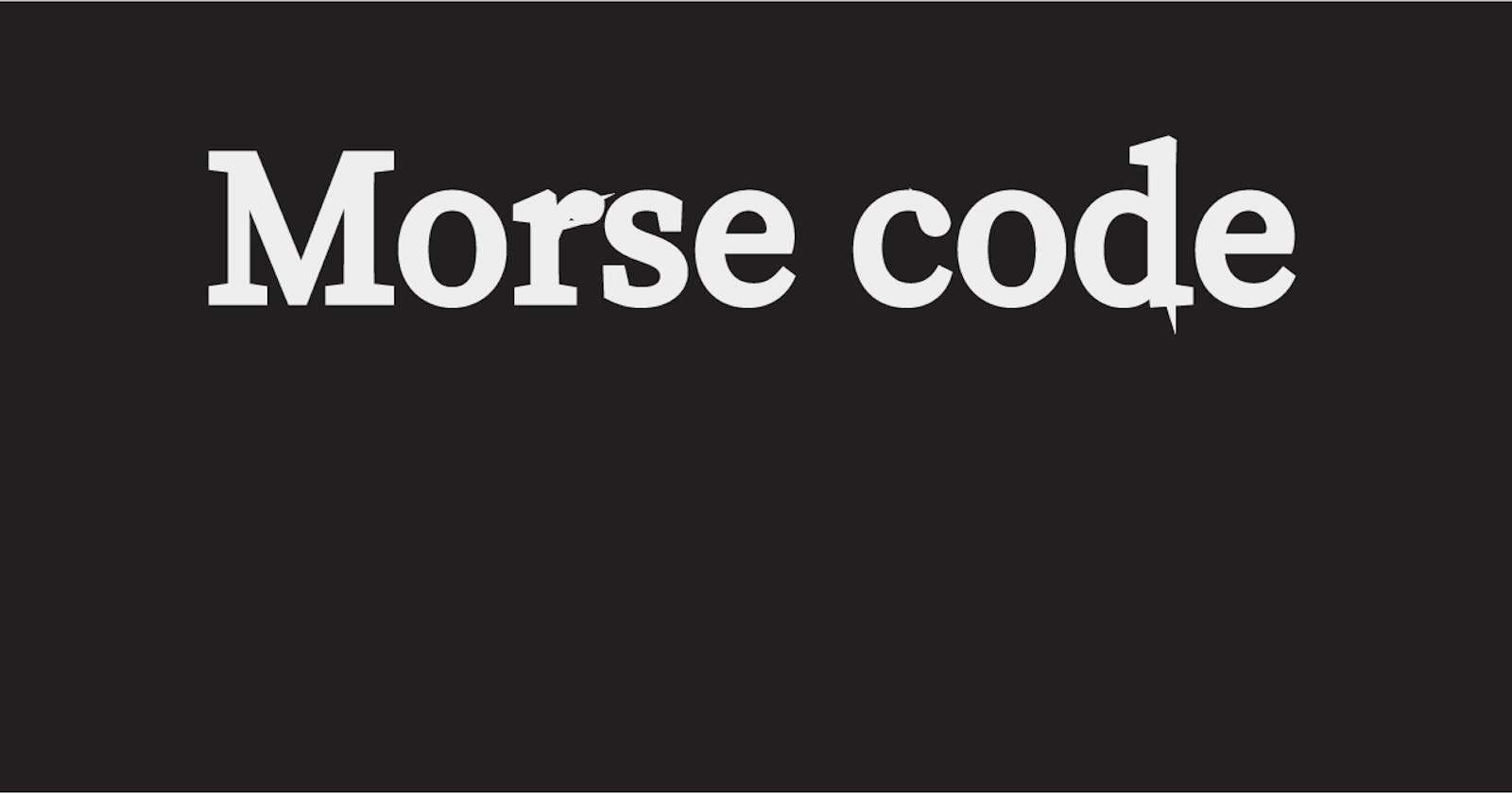A rudimentary Morse Code awakening
How a revolutionary idea sparked in me a (luke++)warm fire to write an article, or maybe articles.
This article is not for the faint-hearted, caffeine-infused, productivity-chasing zealots of the 21st-century hustle-living, insta-scrolling, selfie-posting culture.
No, of course not.
This one is for the misfits to the above, who yet remain unproductive, and sneakily read useless, mindless stuff on the internet - I am one of you.
So, if you are a rebel without a cause, a misfit without a place, or just someone who has some time to kill, read on.
The rest, you have been warned. This article is going to be a so-called, "massive waste of time."
Foreplay
As someone who was chasing peak productivity, fueled by 10 mins of a "productive" YouTube video, I was going in for the kill. The hunt was to "read" Code by Charles Petzold.
Yes, I know, I know. Big kill. Too ambitious. Naive noob. And all that!
And then:
Right on Page 4, I struck, what I call "a daydream dynamite."
I came across Morse Code.
Now, don't roll your eyes just yet. Let me elaborate a bit further.
Almost everyone who's reading this article must have heard of Morse Code in some shape or form, but I would bet that the overwhelming majority don't really know Morse Code. You probably know it as a piece of trivia or something that sometimes plays a minor role in a movie to shoulder the heavy burden of a leaky plot. But, that's the extent of it.
And, I'm the same. Haven't I said that already?
However, the scene in Untraceable (2008) where the guy Morse Codes the villain's location was kinda cool. Or so the 15-year-old me would have said.
Okay, okay! Coming back to the point, or plot, or whatever. Daydream dynamite. What a cringy name! To elaborate this cringe into words, daydream dynamite for me is anything that pulls my mind from its own trajectory towards a new tangent whose protagonist is the aforementioned dynamite. And, that's what happened when I read the chapter related to Morse Code. My mind when whoo hoo! Let's see what we can do with this Morse Code stuff we just learnt. And that, my friend, brings us back to the present (or the future?)
To get put in down concisely, this article is just one of the useless plans concocted, and in that spirit, we shall get on with the article.
Get to the point already
Alright, alright! Hold your tweets! Let me make it clear that I'm not going to be transparent and reveal all my plans. This article will be the preamble to, hopefully, a few more articles, and some other side project(s).
I don't want to redefine Morse Code or write about its history. If you're interested in all that, it's better to check it out on Wikipedia. I couldn't really top that even if I tried.
What I'm really interested in is the pattern of the dots and dashes used to depict each letter, number, or symbol. That's much more interesting than just learning about Morse Code - its history, utility, and the works.
I'm also interested in seeing what I can do with the pattern that I found (if I find any,) and maybe, just maybe, do something utterly innovative from my perspective, and utterly cliche in retrospect. Fingers crossed.
Remove the dunce hat
Let's start off with some unoriginal, plagiarized(?) thoughts, and understanding.
The representation of the dots and dashes are not constant universally; it depends on the user and receiver. For example, you can represent dots and dashes with sounds - dih and dah respectively. Or, you can represent them with light flashes - a short-interval flash denoting dots, and a long-interval flash denoting dashes. Or, you can implement them in some other medium using your own convoluted concoction.
Moreover, since the standard implementation of Morse Code is representative of the alphabets from the English Language, Arabic Numerals, and a small set of commonly used punctuations, there are other factors at play here - the intervals between each signal, the intervals between the letters, and the interval between the words.
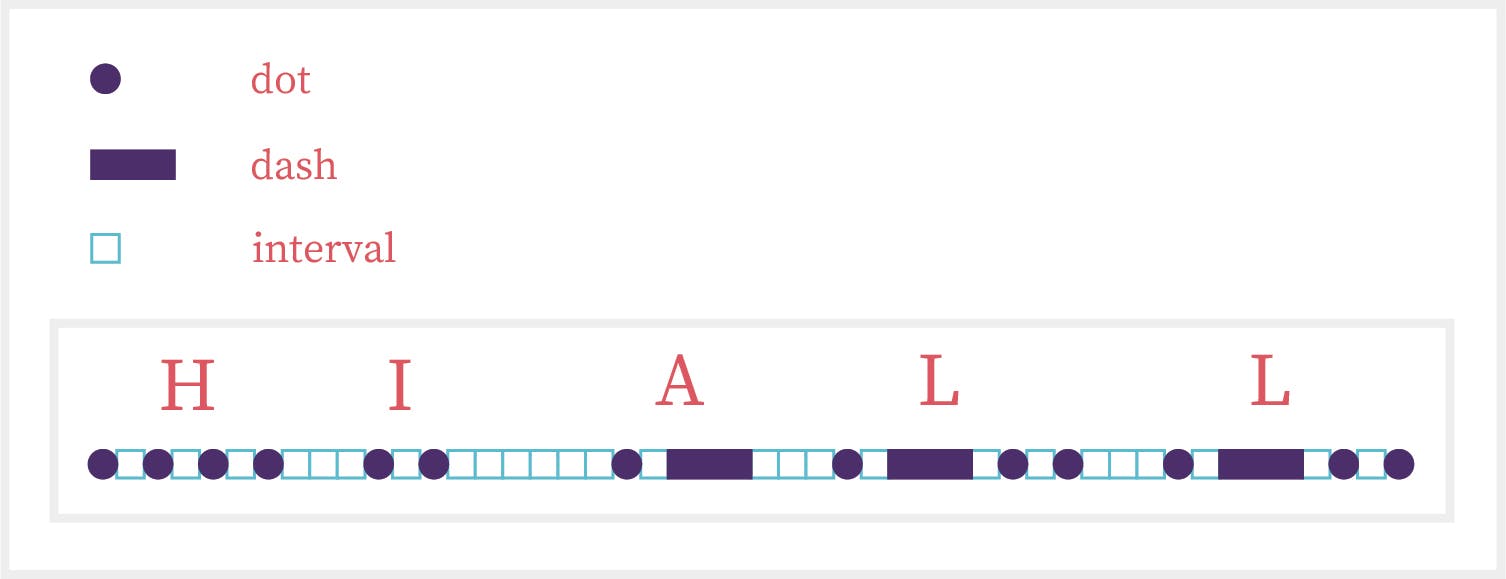
As a general convention, we take the interval of dot as the standard of measurement (when dealing with intervals.) The dash measures three dots. So, for example, if a dot is denoted with an interval of 1 sec, then dash will be 3 secs.
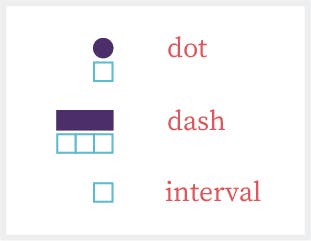
The interval between each signal is one dot. Say, for example, if a dot is of 1 sec, then the dash is 3 secs, and the interval between the symbols while depicting a character is also 1 sec. So, if I was to send the code for A, then the pattern would follow:
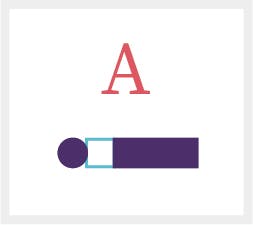
The interval between two letters are denoted with one dash interval. Following, the same example as above. If the dot is 1 sec, then the dash is 3 secs, so the interval between the letters is also 3 secs.
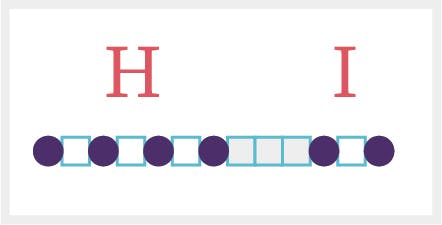
The interval between two words is worth 2 dashes. So, if a dot is 1 sec, a dash is 3 secs, then the interval between two words is 6 secs.

Conclusion?
In conclusion, the entire representation of Morse Code is relative to the interval of a dot. The interval of a dot is entirely dependent on the speed of the sender - a fast sender's dash might be of the same interval of a slow sender's dot. This can cause problems with reading the incoming message. But, generally, after a letter or two, the intervals can be figured out.
It's also interesting to notice that Morse Code essentially uses a pair of symbols, or sounds, or actions. The keyword being pair. With just a pair of something, we can depict anything - a concept which is very familiar to all, I suppose. Hmm.
And, that's a wrap
Is the topic over already? Surely this is not the entire picture?
Yes, you're right. The topic is not over. But, this article is. It already feels like a lengthy read, and any longer than this will definitely make this drab write-up a potent lullaby.
From what has been written thus far, there is not much to draw any sort of conclusions from. However, it's pretty clear that the intervals are not standardized, so the implementation depends on the sender - so there is a human element to this. And, this lack of standardization and precision can even be called romantic (maybe that's a stretch?)
Applause. Bow. Exit.
If you've read this far, thank you. You are among the select few, who like me, don't mind a bit of wasted time. I say, if we don't have the time to waste a bit of time, what the hell are we living for anyway? (Yes, cringy philosophy spewed!)
The topic is not yet over, but you knew that already. There will be a next part coming soon (evasive commitment.)
See you then. AFK.
